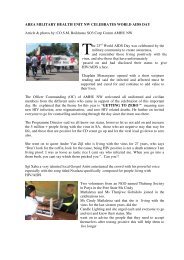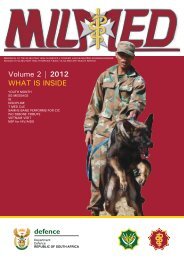MilMed Jan Feb 2007.qxp - SA Military Health Service
MilMed Jan Feb 2007.qxp - SA Military Health Service
MilMed Jan Feb 2007.qxp - SA Military Health Service
You also want an ePaper? Increase the reach of your titles
YUMPU automatically turns print PDFs into web optimized ePapers that Google loves.
Written and photographed by Lt John SverdloffBATLS and BARTS14The <strong>SA</strong>MHS School for <strong>Military</strong> <strong>Health</strong> Trainingconducted the field phase of the BATLS and BARTScourse at Air Force Base Swartkop on 8 <strong>Feb</strong>ruary.The safety officer, Maj Michael Zylstra, explainedthat the term “BATLS”, refers to battlefield advanced traumalife support focusing on doctors, and that “BARTS” refers tobattlefield advanced resuscitation techniques and skills,which focuses on nursing officers and emergency carepractitioners.He added that the course consists of three days’ classroominstruction on advanced life support skills and techniques, aone-day evaluation simulation practical in the simulationlaboratory and a one-day practical field exercise andevaluation under simulated battle conditions.The aim of the course is to teach advanced life supportskills and to teach doctors and emergency care practitionersto operate as a cohesive team during extreme conditions.The primary focus is on the field exercise, which starts withphase one, involving stabilisation of the patient in the field.During this phase, students used battlefield techniqueswhilst en route to their “patients”. Once the patient hadbeen reached, primary and secondary surveys wereconducted and checks were done for life and non-lifethreatening injuries. The course of action to stabilise thepatient was established and executed with the limitedresources available to them. The patient, now stabilised,was reprioritised for air or ground casualty evacuation orboth. Patients were also prioritised for evacuation accordingto the seriousness of their injuries, after which they weremoved to the points of casualty evacuation.The second phase involved casualty evacuation. Studentswaited approximately 50 m away from the grounded Oryxhelicopter, whose rotor blades were still turning. On a signalfrom the pilot or co-pilot to approach and board, themedical section with its “stick” leader in front approachedthe helicopter in single file from the front. After the pilot hadindicated that the medical section could board, the “stick”leader took up her position against the helicopter’s wheelpontoon. The first students at the aircraft climbed into thehelicopter and received the “patient” feet first. They thenplaced the patient on the floor against the side of thehelicopter, and moved him/her toward the rear of theaircraft. Patients are only placed on the floor if no stretcherslings are available in the helicopter. If the patient has chestinjuries or the breathing of the patient is compromised, thepatient is loaded head first due to the effect of the downdraftof the helicopter’s rotor blades being most severe in thearea where the patient’s head would be.All movement inside the helicopter was done in a seated orhands and knees position due to the helicopter’s floorconstruction. The “stick” leader now indicated to the flightengineer that everyone was on board and that all







